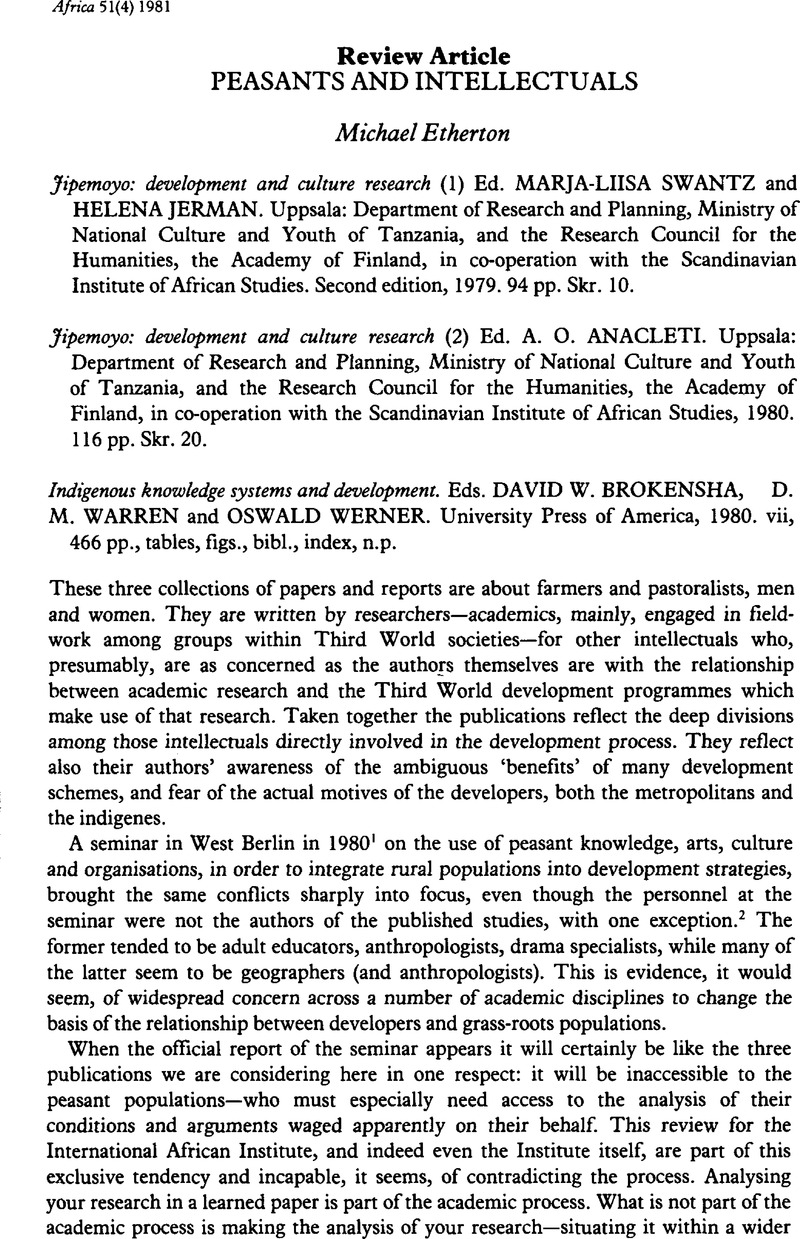Published online by Cambridge University Press: 07 December 2011

* The Jipemoyo Reports are available from: Bagamoyo Project, Institute of Development Studies, University of Helsinki, Luotsikatu 4 A1, SF-00160 Helsinki 16, Finland. They are subsequently referred to as Jipemoyo:…1/1977 and Jipemoyo:…2/1980. Indigenous Knowledge Systems and Development is subsequently referred to as Brokensha et al. (1980).
1 International Seminar on The Use of Indigenous Social Structures and Traditional Media in Non-Formal Education and Development, sponsored by Dse and Icae, and held in West Berlin 5-12 November, 1980.
2 Paul Richards, the author of a paper in , Brokenshaet al. (1980),Google Scholar co-authored one of the seminar's case studies but, curiously, was not invited to the seminar.
3 Gladwin, Hugh, ‘Indigenous knowledge offish processing and marketing utilized by women traders of Cape Coast, Ghana’,Google Scholar, Brokenshaet al. (1980), pp. 131–50Google Scholar.
4 Ibid., p. 148.
5 Swantz, Marja-Liisa, ‘Bagamoyo Research Project ‘Jipemoyo’: introduction to its general aims and approach’, in Jipemoyo:… 1/1977, p. 11.Google Scholar
6 Ibid., p. 13.
7 Bryceson, Deborah, ‘Research methodology and the participatory research approach’, in Jipemoyo:… 2/1980, p. 24.Google Scholar
8 Swantz, Marja-Liisa, ‘Rejoinder…’, op. cit., p. 29.Google Scholar
9 Rigby, Peter, ‘Critical participation, mere observation, or alienation: notes on research among the Baraguyu Maasai’, in Jipemoyo:… 1/1977, pp. 52–79Google Scholar (Baraguyu = Ilparakuyo).
10 Rigby, Peter, ‘Pastoralist production and socialist transformation in Tanzania’, in Jipemoyo:… 2/1980, pp. 32–84.Google Scholar
11 Bryceson, Deborah and Mbilinyi, Marjorie, ‘The changing role of Tanzanian women in production’, op. cit., pp. 85–116.Google Scholar
12 For example, Gladwin, Christina, ‘Cognitive strategies and adoptive decisions…’, in , Brokenshaet al. (1980), pp. 9–28.Google Scholar
13 For example, Brush, Stephen, ‘Potato taxonomies in Andean agriculture’, op. cit., pp. 37–48.Google Scholar
14 For example, Werner, Oswald and Begishe, Kenneth Y., ‘Ethnoscience in applied anthropology’, op. cit., pp. 151–82.Google Scholar
15 For example, Johnson, Allen, ‘Ethnoecology and planting practices in a swidden agricultural system (Brazil)’, op. cit., pp. 49–66.Google Scholar
16 For example, Barker, David, ‘Appropriate methodology: using a traditional African board game in measuring farmers’ attitudes and environmental images’, op. cit., pp. 301–6.Google Scholar
17 For example, Howes, Michael and Chambers, Robert, ‘Indigenous technical knowledge: analysis, implications and issues’, op. cit., pp. 329–40.Google Scholar
18 , Rigby, in Jipemoyo:…2/1980, p. 39.Google Scholar
19 Rigby, Peter, ‘Critical participation, mere observation, or alienation: notes on research among the Baraguyu Maasai’, Jipemoyo:…1/1977, pp. 52–79.Google Scholar
20 , Brokenshaet al. (1980), Introduction, p. 5Google Scholar
21 Ibid., p. 5.
22 Ibid., p. 6.
23 Ibid., p. 6.
24 Ibid., p. 7.
25 Ibid., p. 8.
26 Scott, Michael F., and Gormley, Brendan, ‘The Animal of Friendship (Habbanaae): an indigenous model of Sahelian pastoral development in Niger’, op. cit., p. 110.Google Scholar
27 T. O. Ranger gives an interesting account of the organisation and aesthetic of dance societies which came to criticise colonial authority in Dance and Society in Eastern Africa 1890-1970: The Beni Ngoma, London: Heinemann Educational, 1975Google Scholar.